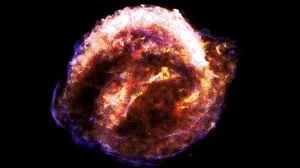Scientists monitor for the first time the moment a giant star explodes and turns into a supernova
The telescopes involved in the observations have obtained a huge amount of data that will help advance scientists' understanding of the evolution of stars from the red supergiant stage to the supernova stage.
For the first time ever, an American research team was able to monitor the moments when a supergiant star transformed into a supernova, which opens the door to challenging previous ideas about how giant stars of this type evolve.
According to the study published in The Astrophysical Journal, this team used two telescopes in the US state of Hawaii - the Haleakala Observatory and the Keck Observatory - during the summer of 2020, to monitor a group of very giant red stars.
This star actually gave off a higher amount of radiation than expected during that period, and then exploded in the fall of the same year as scientists followed it, and is now known as the supernova "SN 2020tlf" (SN 2020tlf).
Star death
The super red giant is one of the stages of evolution of large stars, which are more than 8 times more massive than the sun, and their color is usually red because of their low surface temperature, which stands around 3500 degrees Celsius.
In the nuclei of these stars, the elements are transformed through nuclear fusion into other elements, the matter begins with the conversion of hydrogen into helium, and then other elements appear, such as nitrogen, oxygen, carbon and others, all the way to iron.
When iron is formed inside the star, the latter does not have an appropriate amount of energy to enter the iron into additional nuclear fusion that maintains its stability, and the star collapses on itself in a fraction of a second to make a supernova, an explosion of such magnitude that we can see it happening at a distance of tens of Millions of light years.
After that, the star leaves in its place one of two types of star development stages, either a neutron star, usually in the diameter of a small city but in the mass of one or two suns, or a stellar black hole devouring everything that approaches it of material.
Disaster simulation
According to the new study, this discovery challenges previous ideas about how stars of this type develop, as researchers believed that they remain completely quiet until the moment of the explosion, but it turns out that this does not apply in all cases, as the star emits a huge amount of radiation before it explodes, which It means that it has undergone significant changes in its internal structure.
An official statement issued by the Keck Observatory, which is involved in the study, stated on January 6 that the telescopes participating in the observations obtained a huge amount of data that will help scientists understand the evolution of stars from the super red giant stage to the supernova stage.
The research team used this data to build an accurate simulation of the star's first explosion moments.
Tags:
cambridge science
electrical sciences
genomic sciences
geosciences
life science
live science
neuroscience
science
science magazine
space science
strait of science



